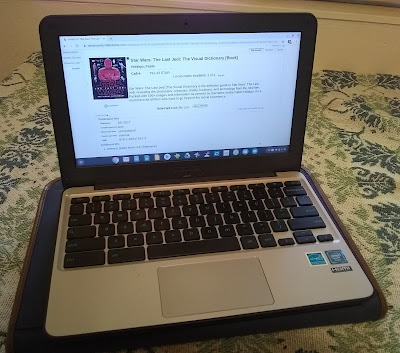 |
| This item’s catalog record includes a summary and identifies grade-level interest |
One of the ways I utilize my training in library technical services is to augment “brief” catalog records. A “brief” catalog record contains only the bare minimum of information about an item in a library. Maybe it includes the item’s name, the name of the author, the ISBN, and the assigned call number, maybe the name of the publisher and the date of publication.
“Brief” records get the job done; they enable an item to be found if the user inputs the right search-term. But adding more information to an item’s record really boosts its “discoverability,” and helps the user conclusively determine if that item is what the user wants.
The online interface I work with, relies on “Machine Readable Cataloging,” otherwise known as MARC. In its programming language, each field in the record is identified by a number, which identifies to the computer what type of information is contained in that field.
For example, MARC tag 245 identifies the title of a book. A person browsing that record doesn’t see the number, but the online catalog “sees” and interprets it.
In a webinar recording I recently viewed, about “Cleaning Up Your Catalog,” the presenter identified a “brief” record in the catalog as a record without MARC tags from 305 to 899. Non-cataloging readers need only understand those missing numbers represent a lot of information that could potentially help customers locate items or evaluate them for suitability.
Some of the things missing from a “brief” catalog record include:
The summary (520), which briefly describes the item (like the plot of a book).
A target audience note (521), which identifies the reading or interest level.
Awards won by the item (586), which can help indicate its quality.
Subject listings (650), which use consistent language when describing an item’s subject, so that the user can easily browse all items tagged with that subject.
Genre and/or form (655), e.g. “Graphic novels.” “Realistic Fiction.”
My library’s cataloging software allowed me to locate “brief” records in the catalog. I saved those items to a resource list to make them easily recallable. Then, as I update and expand upon their records, I can remove them from the list.
The age of an item is an important consideration, whether or not I make this effort. The “brief” record for an item that was published in, say, 1996, is perhaps a signpost for an item that should be weeded from the library. At the very least, older items should be evaluated for their continuing relevance.
Among special considerations when cataloging:
The “Easy Editor” view for editing records in my library’s online catalog contains a drop-down menu for setting the item’s interest level — but according to Michael Sullivan writing Fundamentals of Children’s Services (American Library Association, 2013), assigning these levels is potentially a “huge source of disagreement” and should not be made by the librarian. Instead, Sullivan argues, they should be taken from some other source, with that source noted in the cataloging record.
The “Easy Editor” drop-down menu doesn’t include a provision for identifying the source; you simply pick the interest range you want. So after making my selection, I switch to the “MARC Editor” and add a sub-field where I can identify the determination’s source.
No comments:
Post a Comment
Robust debate and even unusual opinions are encouraged, but please stay on-topic and be respectful. Comments are subject to review for personal attacks or insults, discriminatory statements, hyperlinks not directly related to the discussion and commercial spam.